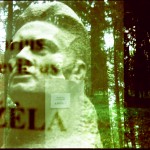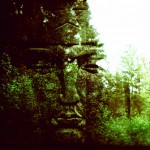July 11, 2009
The first few images I’m working with from my series on Grutas Park in Lithuania. I hope to be back there, deep in the forest, with Veronika Krausas next summer on a collaborative project. More about that later.
Anyway, the Grutas Park story is quite spectacular. When Lithuania regained its independence in 1990, former wrestler Viliumas Malinauskas – whose father was exiled and murdered by Stalin – began searching for the hundreds of destroyed and discarded Soviet-era ideological public sculptures that had been consigned to scrap metal vendors, recycling facilities, and garbage dumps. Although detested as symbols of the occupation and genocide, the statues were nonetheless works of art, forcibly commissioned by the Soviets from acclaimed Lithuanian artists.
The idea of a forcible commission continues to provide much source for thought – add to that the forced creation of totalitarian ideological propaganda whose key enterprise is genocide and terror. One day, you’re moulding bronze figures of the family cat…until that knock at the door…
However, back to the story. With these reclaimed ideological artworks, the Pickled Mushroom King and Wrestling Prince (I think mushroom pickles far outrank wrestling match in amusement park regent ranking) created the GRUTO PARKAS, also known as Stalin World Theme Park and Sculpture Garden in the wetlands of Druskininkai.
Now re-ideologized as a scathing critique of Stalin’s crimes against humanity, the propaganda statues rise through this same forest alongside other (less clearly visible) gods and demons.
The park was silent and empty in the spring morning that we went there, and we had it to ourselves. We each experienced a strangely syncopated mixture of grief and hilarity (according to Mel Brooks, it’s a common mixed response to genocide and totalitarianism. Nothing like an anti-fascism amusement park to truly exemplify that gestalt…). This emotional toggling ensured that whichever emotion rising to the surface felt inappropriate – one of us would crack a joke or strike an insouciant pose, only to stumble upon someone blotting back tears – and of course vice versa.
I would like to come back and shoot with Russian Stalin-era cameras, as to me there always does seem to be a different sense of place and mood when the film runs through a local camera. Ghosts re-familiarizing themselves with other long-lost ghosts, straining their filmic eyes to see through that brief moment of a shutter. Or a shudder…



